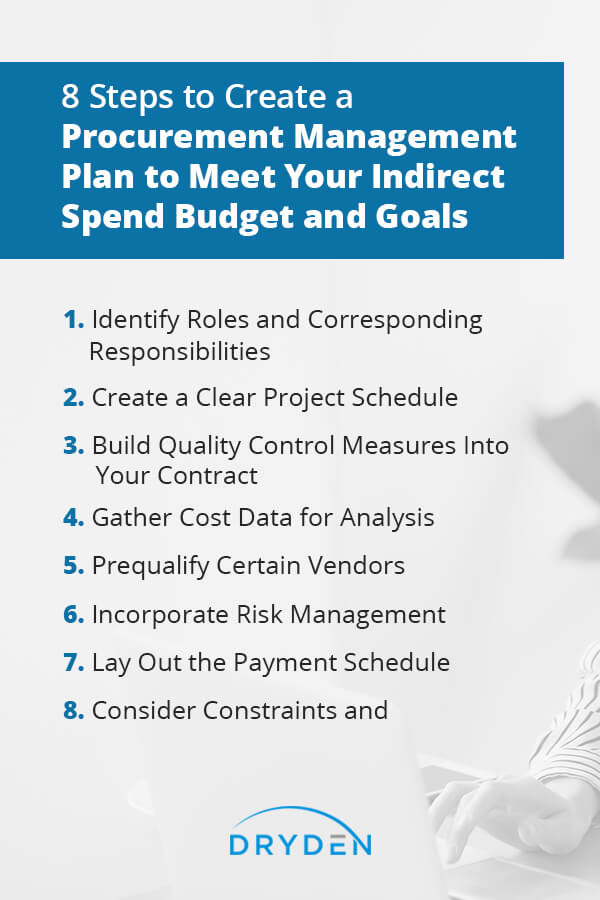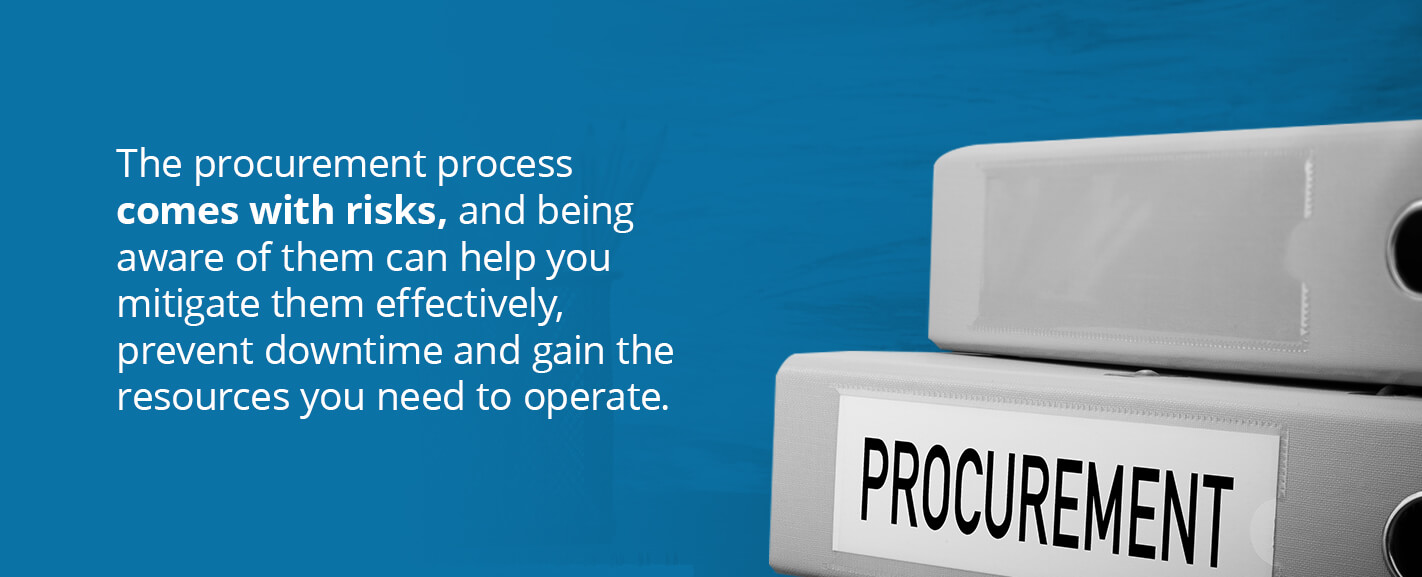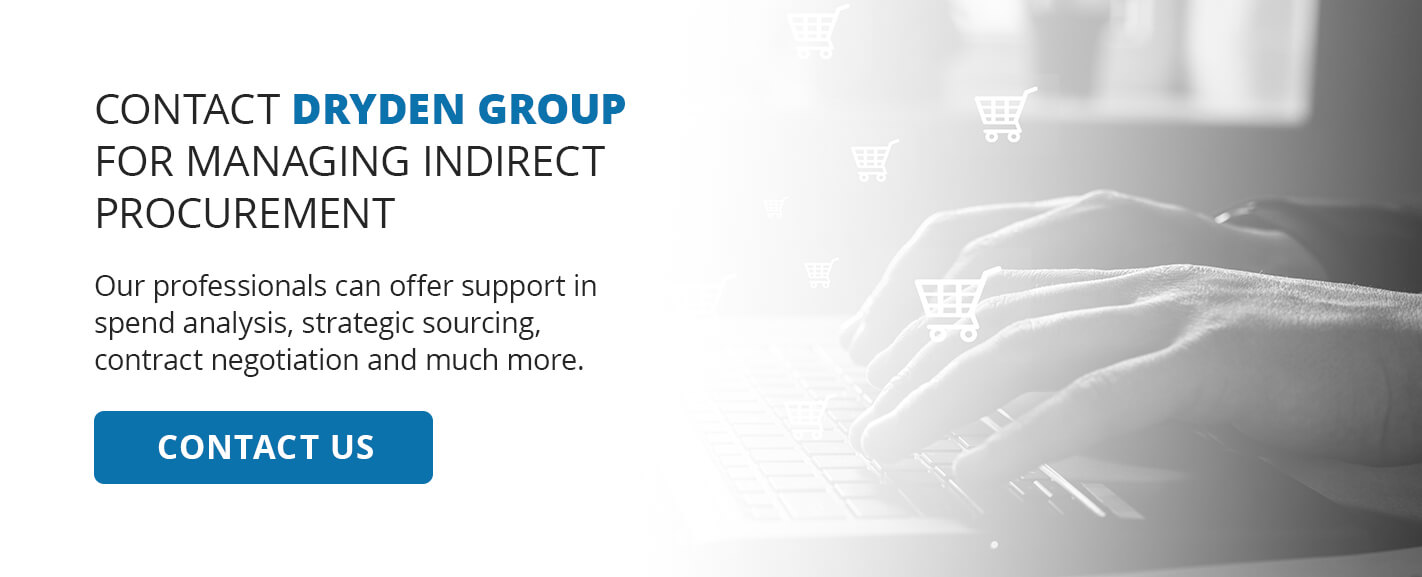How to Create a Procurement Management Plan to Meet Your Indirect Spend Goals
Last updated: March 8, 2022
Indirect spending is all the materials, products and services your company needs to operate, like rent, utilities, office supplies and equipment maintenance. These expenses are essential to your business, but they can increase quickly if you disregard your procurement process.
Direct procurement often takes priority because it relates to your product or service — and ultimately your reputation. However, indirect procurement offers many opportunities to cut costs and optimize supplier relationships, so you can save on various background expenses and increase revenue over time.
With a procurement management plan, you can define your priorities, find ways to reduce costs and improve efficiency across the board. At Dryden Group, we can offer the professional support you need to manage indirect procurement spend and optimize your management plan.
What Is a Procurement Management Plan?
A procurement management plan defines all the processes that lead to contract terms with your vendors. Your indirect procurement involves factors like:
- Scheduling
- Payment
- Risk management
- Vendor control
- Prequalification
- Constraints and assumptions
- Cost analysis
A management plan will help you address these various aspects and define them before you finalize your contracts with suppliers.
These management plans act as references for your procurement process, and they should be flexible. Your acquisition needs may change throughout the lifecycle of a project, so it's vital to treat your plan as a guideline for your process. Consider your management plan an organizational strategy to keep your stakeholders and internal team members informed throughout your project.

Procurement management is important because it helps you work through the process more efficiently and makes you more agile when changes are necessary. Your team can optimize its resources by knowing what to expect from the procurement process.
What Are the Benefits of a Procurement Management Plan?
Procurement management plans are valuable to every business, regardless of industry or scope. With these plans in place, your team can experience several benefits.
Increase Predictability
Many companies lack supply chain transparency. In fact, only 6% of companies in the United States report having full visibility into their supply. When your procurement process is summarized through a management plan, your company will know what to expect as it moves through each procurement function.
Making your procurement process more predictable and consistent can reduce errors and improve efficiency. When you work through your procurement process blindly, you're more likely to make costly mistakes or decisions that fail to meet your goals.
Consistency offers the peace of mind your company needs when collaborating with stakeholders and aiming to increase revenue. When you're dealing with indirect expenses, this predictability ensures you'll have the resources you need to run your business.
Adjust Requirements
Even when you think you have a concept of what you need for a procurement project, your requirements change. When you oversee the process with a management plan, you can find out where projected resources, expenses, contract needs and more are missing the mark.
Catching these adjustments in the middle of the procurement process can be challenging to address. Doing so beforehand makes it easier to adjust your approach before you've spent time and money in the wrong areas.
Enhance Communication
Procurement can involve several internal departments and external stakeholders. With so many moving parts in the process, communication is key to having your expectations met, maintaining strong supplier relationships and staying efficient.
Without a management plan, your company may face unhappy vendors, low-quality products and schedule bottlenecks that set you back. Your management plan will help your team determine its priorities, so it can share them with your suppliers and keep your procurement on track.
Estimate Time
Time is one of your most valuable resources, and being able to estimate it effectively will help you reduce downtime and the associated operating costs. Your management plan will consider the technical processes your suppliers will work through and the schedule they'll keep to meet your needs.
While your vendors may not be able to uphold the exact schedule you lay out, the estimation offers benefits in itself. You can more effectively coordinate one vendor's responsibility with another, and you can keep the entire process running smoothly from beginning to end.
Optimize Processes
When you have a procurement management plan, you have a benchmark for real-world performance. During the planning stage, you'll make estimations based on what you think your vendors and internal team are capable of. If your actual performance falls short, you can identify gaps in your processes and find solutions for them.
For example, if you expect a vendor to achieve a specific level of quality and they can't meet it, you can assess why. Perhaps your vendor isn't qualified for your needs, and a replacement is necessary. You may also find your quality standards are unrealistic. Making these small changes throughout your processes can make a significant difference in your efficiency.

8 Steps to Create a Procurement Management Plan to Meet Your Indirect Spend Budget and Goals
The process of indirect procurement has to consider several factors, ranging from scheduling and costs to risk management. At Dryden, we support your team through the planning phase, so you can develop an effective strategy for procurement. Our experts will discuss your goals with you to determine the best approach, and we collect data to generate valuable insights about your indirect spending.
If you apply key concepts to your procurement management plan in addition to our services, you can optimize your strategy. Working through the following management plan can help you control indirect costs during the procurement process and get the best value for your money.
1. Identify Roles and Corresponding Responsibilities
Throughout the procurement process, you'll rely on many roles to keep the operation running smoothly. These roles and responsibilities often overlap with one another, so it's essential to create clear boundaries for each position. This first step keeps your team organized, prevents any confusion during procurement and ensures you use your employee resources effectively.
Some of the notable roles involved in procurement are:
- Project managers: Your project managers will oversee procurement and act as a point of contact for other people involved. These professionals also handle budgets, scheduling and project risks.
- Contract managers: This role provides advice for the contract process and maintains documentation when you establish supplier relationships and negotiate provisions.
- Technical managers: These professionals create the statement of work (SOW) for your contractors and outline the technical requirements for the project.
- Corporate executives: Corporate executives often collaborate with contract managers to make decisions about contractual agreements. They may also approve these documents before they become official deals.
- Lawyers: This role focuses on compliance throughout the process and may offer support for contracting.
With these key players collaborating effectively, you can create contracts that suit your indirect spend budget as well as manage supplier relationships to find the most competitive costs on the market. When you work with Dryden, our team of experts uses industry-leading tools to draft optimal contracts for your project, so you can experience cost savings in the long term.
2. Create a Clear Project Schedule
Creating a schedule ensures every aspect of procurement is completed according to your timeline. If you're unable to complete processes on time, it can lead to additional operating costs and unwanted downtime. Scheduling is also valuable for communicating expectations to your stakeholders. When your contractors understand what you expect from them, they can more effectively deliver on their end of the contract.
3. Build Quality Control Measures Into Your Contract
Based on a survey conducted in 2019, 34% of companies do not know how their suppliers are performing during the procurement timeline.
Once you've clarified the schedule, any work that your contractor does each day is out of your hands. Since it's not your responsibility to micromanage every vendor, you should create quality control measures that illustrate when a vendor's work is acceptable. This process ensures you receive the best possible product for the agreed-upon price.
You can build these quality control measures through various means. Ultimately, it depends on what you're requesting from your vendor and how your materials or services need to perform. Possible quality control measures can include:
- Measurements for product quality, such as dimensions or shape
- Site inspections for vendors and external production facilities
- Regular project meetings to assess progress
Once you determine your quality measures, you need to integrate them with the SOW and contract. This documentation will act as a legally binding agreement for your vendors and give them reference materials during production.
While the day-to-day concerns are out of your hands, your suppliers should provide regular project updates as you work. Their progress will alert you to any potential bottlenecks or other costly risks.
4. Gather Cost Data for Analysis
Your procurement process needs to maximize revenue with every dollar spent, and cost data can help you forecast possible expenses before you follow through with them. With these estimations, you can optimize your procurement strategy to get the resources you need with the lowest possible costs.
Cost data uses historical procurement data and current market values to estimate how much something will cost. Big data like this is a valuable tool for managing indirect expenses because it can generate fairly accurate insights.
Once you've created projected costs, you can compare prices and set benchmarks for specific resources. While maintaining and analyzing cost data is a continuous task, your company can reap many benefits from it throughout the procurement process. Procurement spend analytics can also address your company's overall spending habits and identify ways to save across the organization.
At Dryden, we conduct cost analyses for your team, so you can create effective expense estimates and procurement plans for your project.
5. Prequalify Certain Vendors
Prequalified vendors are suppliers that meet a list of predetermined characteristics called a Request for Qualifications. These requests do not look at pricing information, but they do consider a vendor's suitability for a job.
Prequalification looks at three categories:
- The project team and its capabilities
- Methodology for completing projects
- Past projects
You can use prequalified vendors for a single project or retain a list for reference at any time. These lists can help you save time during the vendor selection process and get a project started as quickly as possible.
6. Incorporate Risk Management Techniques

The procurement process comes with risks, and being aware of them can help you mitigate them effectively, prevent downtime and gain the resources you need to operate. There are several possible risks your organization can face as it works with vendors. For example, in late 2020, the United States hit record high delivery times caused by massive supply chain disruptions.
Other possible risks your company may face include:
- Fraud
- Price instability
- Poor supplier performance
- Inaccurate forecasts
Risk management is the process of identifying possible risks and creating a response plan for when they arise. In response to the supply chain disruptions, you can assess your vendors to determine which ones are most at risk for delivery issues. Keeping secondary suppliers on standby can also be beneficial.
While your risk management strategies won't be able to prevent procurement challenges from happening, they can give you more control. When you can respond to risks quickly, you can save time and money.
7. Lay Out the Payment Schedule
Your procurement management plan should describe preferred methods and currencies for clarity in your vendor contracts. Your team may opt to pay based on progress through monthly installments, but you might collaborate with your suppliers to determine a method that works for both of you.
8. Consider Constraints and Assumptions
Constraints are limitations that can affect the quality of your project, and assumptions are the factors you know to be true that you can build your project upon. Every procurement process will encounter constraints and assumptions, so it's vital to integrate them into your management plan.
An assumption may be the specifications for the project. If you know what resources you need, you choose your vendors and determine your costs based on this assumption. A constraint could be your timeline. When you have a small window of time to finish the project, you have to choose vendors that can stay on schedule.
Constraint and assumption lists can be extensive, but taking the time to build them out will make your management plan and overall process much smoother.
Contact Dryden Group for Managing Indirect Procurement
At Dryden Group, we provide a range of services to support your indirect procurement process. Our professionals can offer support in spend analysis, strategic sourcing, contract negotiation and much more. When you're developing your management plan, our services can help you stay organized, increase cost savings and optimize revenue.
The Dryden team is efficient and can integrate seamlessly with your sourcing department to deliver valuable changes to your procurement process, regardless of how much money you spend. Our extensive expertise allows us to effectively negotiate across industries.
Your bottom line is our top priority. Get in touch with us today to learn more about our capabilities.
